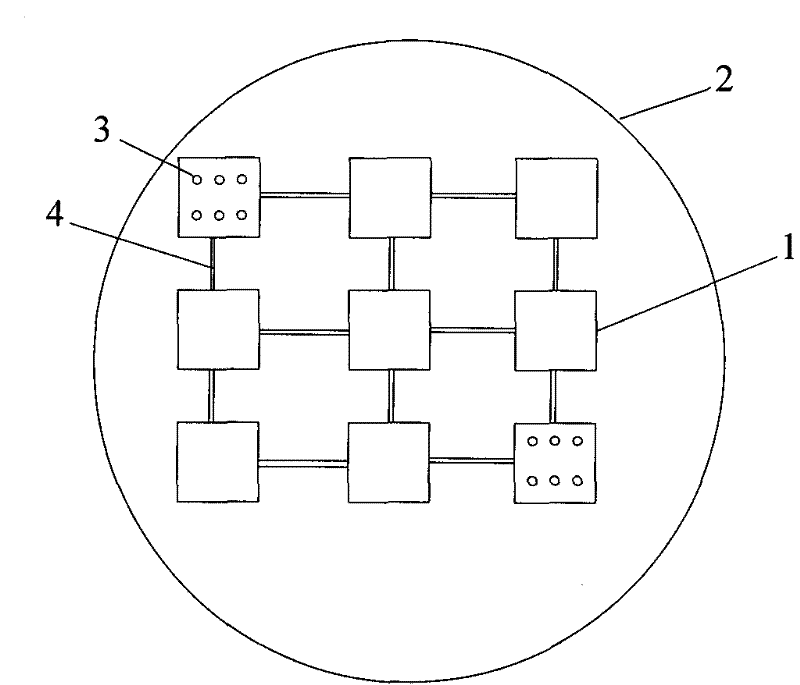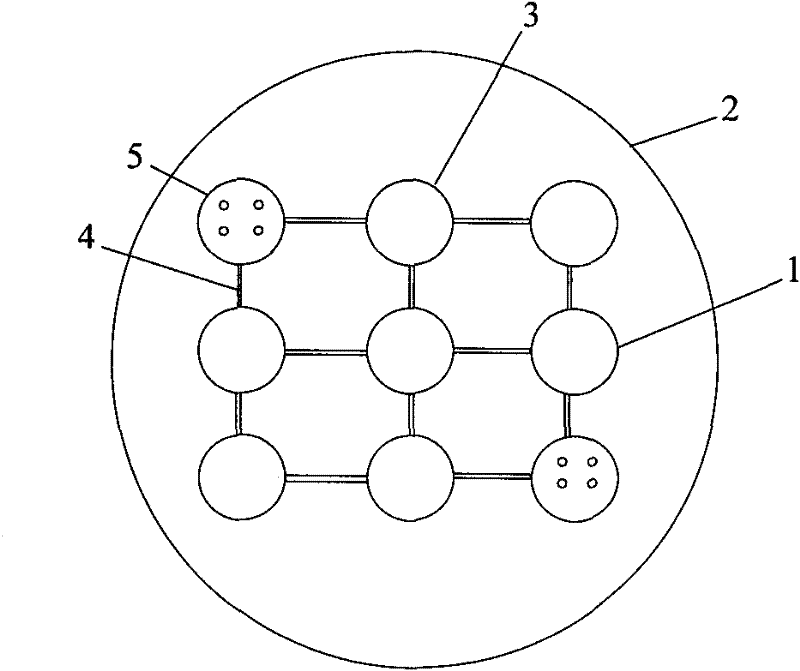Method for preparing wafer-level uniform-dimension glass microcavity by positive pressure thermal forming
A wafer-level, thermoforming technology, applied in manufacturing tools, welding equipment, microstructure technology, etc., can solve the problems of increased cost, long time, high cost, etc., and achieve the effect of low cost, simple method, and good sphericity
- Summary
- Abstract
- Description
- Claims
- Application Information
AI Technical Summary
Problems solved by technology
Method used
Image
Examples
Embodiment 1
[0023] A method for preparing wafer-level uniform size glass microcavities by positive pressure thermoforming includes the following steps: an array formed by engraving the same microgrooves on a silicon wafer (the size of the microgrooves is the same), and the method for etching the microgrooves can be Dry method and wet method, wet method is preferred (the depth of the microgrooves required by the present invention can be placed in the hot outgassing agent, so a shallower depth of wet etching can meet the requirements, such as a depth of 50-100 microns) , The etched multiple microgrooves have the same size (for example, 5, 10, 15, 50), and the microgrooves are connected with microchannels. The minimum groove width of the microgrooves is greater than 5 times the width of the flow channel. Place an appropriate amount of hot air release agent in at least one of the microgrooves (the hot air release agent can be placed in two or more micro grooves, and the amount of the hot air re...
Embodiment 2
[0026] A method for preparing wafer-level uniform-size glass microcavities by positive pressure thermoforming includes the following steps:
[0027] In the first step, a 5000A oxide layer is oxidized on a single-sided polished silicon wafer by a method of combining dry and wet oxygen, and the polished surface is spin-coated with AZ P4620 photoresist, and exposed and developed to remove the photoresist that needs to be etched on the surface of the microgroove. The microcavity and the microchannel shallow grooves are etched on the 4-inch Si wafer using the Si micromachining process. The microchannels connect the shallow grooves. The silicon wafer used can be a standard thickness silicon wafer with a thickness of 500 microns. The depth of the groove is 60-100 microns, and the microgroove is a square groove with a width of 2000 microns. The microchannel used to connect two microgrooves is a strip groove with a width of 50 microns. The groove length is 5 mm and connects two adjacent mi...
Embodiment 3
[0033] A method for preparing wafer-level uniform-size glass microcavities by positive pressure thermoforming includes the following steps:
[0034] In the first step, a 5000A oxide layer is oxidized on a single-sided polished silicon wafer by a method of combining dry and wet oxygen, and the polished surface is spin-coated with AZ P4620 photoresist, and exposed and developed to remove the photoresist that needs to be etched on the surface of the microgroove. The microgrooves and microchannels are etched on the 4-inch Si wafer using the Si micromachining process. The microchannels connect the microgrooves. The silicon wafer used can be a standard thickness silicon wafer with a thickness of 500 microns. The depth of the microgrooves is 60-100 micron square groove with a width of 2000 micrometers. The number of micro grooves is 15 and the same size. The microchannel groove is a strip groove with a diameter of 50 micrometers, and the groove length is 5 mm. It connects two adjacent mi...
PUM
| Property | Measurement | Unit |
|---|---|---|
| depth | aaaaa | aaaaa |
| diameter | aaaaa | aaaaa |
Abstract
Description
Claims
Application Information
 Login to View More
Login to View More - R&D
- Intellectual Property
- Life Sciences
- Materials
- Tech Scout
- Unparalleled Data Quality
- Higher Quality Content
- 60% Fewer Hallucinations
Browse by: Latest US Patents, China's latest patents, Technical Efficacy Thesaurus, Application Domain, Technology Topic, Popular Technical Reports.
© 2025 PatSnap. All rights reserved.Legal|Privacy policy|Modern Slavery Act Transparency Statement|Sitemap|About US| Contact US: help@patsnap.com



